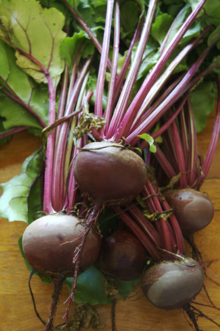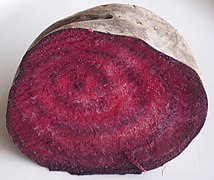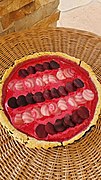| Beetroot | |
|---|---|
 Beetroots on the stem Beetroots on the stem | |
| Species | Beta vulgaris |
| Subspecies | Beta vulgaris subsp. vulgaris |
| Cultivar group | Conditiva Group |
| Origin | Sea beet (Beta vulgaris subsp. maritima) |
| Cultivar group members | Many; see text. |
The beetroot (British English) or beet (North American English) is the taproot portion of a Beta vulgaris subsp. vulgaris plant in the Conditiva Group. The plant is a root vegetable also known as the table beet, garden beet, dinner beet, or else categorized by color: red beet or golden beet. It is also a leaf vegetable called beet greens. Beetroot can be eaten raw, roasted, steamed, or boiled. Beetroot can also be canned, either whole or cut up, and often are pickled, spiced, or served in a sweet-and-sour sauce.
It is one of several cultivated varieties of Beta vulgaris subsp. vulgaris grown for their edible taproots or leaves, classified as belonging to the Conditiva Group. Other cultivars of the same subspecies include the sugar beet, the leaf vegetable known as spinach beet (Swiss chard), and the fodder crop mangelwurzel.
Etymology
Beta is the ancient Latin name for beetroot, possibly of Celtic origin, becoming bete in Old English. Root derives from the late Old English rōt, itself from Old Norse rót.
History
The domestication of beetroot can be traced to the emergence of an allele that enables biennial harvesting of leaves and taproot. Beetroot was domesticated in the ancient Middle East, primarily for their greens, and were grown by the Ancient Egyptians, Greeks, and Romans. By the Roman era, it is thought that they were also cultivated for their roots. From the Middle Ages, beetroot was used to treat various conditions, especially illnesses relating to digestion and the blood. Bartolomeo Platina recommended taking beetroot with garlic to nullify the effects of "garlic-breath".
During the middle of the 17th century, wine often was colored with beetroot juice.
Food shortages in Europe following World War I caused great hardships, including cases of mangelwurzel disease, as relief workers called it. It was symptomatic of eating only beetroot.
Culinary use
| Nutritional value per 100 g (3.5 oz) | |||||||||||||||||||||||||||||||||||||||||||||||||
|---|---|---|---|---|---|---|---|---|---|---|---|---|---|---|---|---|---|---|---|---|---|---|---|---|---|---|---|---|---|---|---|---|---|---|---|---|---|---|---|---|---|---|---|---|---|---|---|---|---|
| Energy | 180 kJ (43 kcal) | ||||||||||||||||||||||||||||||||||||||||||||||||
| Carbohydrates | 9.56 g | ||||||||||||||||||||||||||||||||||||||||||||||||
| Sugars | 6.76 g | ||||||||||||||||||||||||||||||||||||||||||||||||
| Dietary fiber | 2.8 g | ||||||||||||||||||||||||||||||||||||||||||||||||
| Fat | 0.17 g | ||||||||||||||||||||||||||||||||||||||||||||||||
| Protein | 1.61 g | ||||||||||||||||||||||||||||||||||||||||||||||||
| |||||||||||||||||||||||||||||||||||||||||||||||||
| Other constituents | Quantity | ||||||||||||||||||||||||||||||||||||||||||||||||
| Water | 87.58g | ||||||||||||||||||||||||||||||||||||||||||||||||
Link to USDA Database entry | |||||||||||||||||||||||||||||||||||||||||||||||||
| Percentages estimated using US recommendations for adults, except for potassium, which is estimated based on expert recommendation from the National Academies. | |||||||||||||||||||||||||||||||||||||||||||||||||
Usually, the deep purple roots of beetroot are eaten boiled, roasted, or raw, and either alone or combined with any salad vegetable. The green, leafy portion of the beetroot is also edible. The young leaves can be added raw to salads, while the mature leaves are most commonly served boiled or steamed, in which case they have a taste and texture similar to spinach. Beetroot can be roasted, boiled or steamed, peeled, and then eaten warm with or without butter; cooked, pickled, and then eaten cold as a condiment; or peeled, shredded raw, and then eaten as a salad. Pickled beetroot is a traditional food in many countries.
Australia and New Zealand
In Australia and New Zealand, sliced pickled beetroot is a common ingredient in traditional hamburgers.
Eastern Europe
In Eastern Europe, beetroot soup, such as borscht and barszcz czerwony , is common. In Ukraine, a related dish called "shpundra" is also common; this hearty beetroot stew, often made with pork belly or ribs, is sometimes referred to as a thicker version of borscht. In Poland and Ukraine, beetroot is combined with horseradish to form ćwikła or бурячки (buryachky), which is traditionally used with cold cuts and sandwiches, but often also added to a meal consisting of meat and potatoes.
Similarly, in Serbia, beetroot (referred to by the local name cvekla) is used as winter salad, seasoned with salt and vinegar, with meat dishes.
As an addition to horseradish, it is also used to produce the "red" variety of chrain, a condiment in Ashkenazi Jewish, Hungarian, Polish, Lithuanian, Russian, and Ukrainian cuisine.
Cold beetroot soup called "Šaltibarščiai" is very popular in Lithuania. Traditionally it consists of kefir, boiled beetroot, cucumber, dill, spring onions and can be eaten with boiled eggs and potatoes.
Botvinya [ru] is an old-time traditional Russian cold soup made from leftover beet greens and chopped beetroots, typically with bread and kvass added. Botvinya got its name from the Russian botva, which means "root vegetable greens", referring to beet plant leaves.
Svekolnik [ru], or svyokolnik, is yet another Russian beet-based soup, typically distinguished from borscht in that vegetables for svekolnik are cooked raw and not sauteed, while many types of borscht typically include sauteed carrots and other vegetables. Svekolnik got its name from svyokla, Russian word for "beet." Sometimes, various types of cold borscht are also called "svekolnik".
India
In Indian cuisine, chopped, cooked, spiced beetroot is a common side dish. Yellow-colored beetroots are grown on a very small scale for home consumption.
North America
Besides standard fruit and vegetable dishes, certain varieties of beets are sometimes used as a garnish to a tart.
Northern Europe
A common dish in Sweden and elsewhere in the Nordic countries is Biff à la Lindström, a variant of meatballs or burgers, with chopped or grated beetroot added to the minced meat.
In Northern Germany, beetroot is mashed with Labskaus or added as its side order.
Industrial production and other uses
A large proportion of commercial production is processed into boiled and sterilized beetroot or pickles.
Betanin, obtained from the roots, is used industrially as red food colorant to enhance the color and flavor of tomato paste, sauces, desserts, jams and jellies, ice cream, candy, and breakfast cereals. When beetroot juice is used, it is most stable in foods with low water content, such as frozen novelties and fruit fillings.
Beetroot can be used to make wine.
Nutrition
Raw beetroot is 88% water, 10% carbohydrates, 2% protein, and less than 1% fat (see table). In a 100-gram (3+1⁄2-ounce) amount providing 180 kilojoules (43 kilocalories) of food energy, raw beetroot is a rich source (27% of the Daily Value (DV)) of folate and a moderate source (16% DV) of manganese, with other nutrients having insignificant content (table).
Health effects
A clinical trial review reported that consumption of beetroot juice modestly reduced systolic blood pressure but not diastolic blood pressure.
Pigment
The red color compound betanin is a betalain in the category of betacyanins. It is not broken down in the body, and in higher concentrations, may temporarily cause urine or stools to assume a reddish color, in the case of urine a condition called beeturia.
Although harmless, this effect may cause initial concern as a medical problem due to a visual similarity with blood in the stool, blood passing through the anus (hematochezia), or blood in the urine (hematuria).
Nitrosamine formation in beetroot juice can reliably be prevented by adding ascorbic acid.
Cultivars
Below is a list of several commonly available cultivars of beetroot. Generally, 55 to 65 days are needed from germination to harvest of the root. All cultivars can be harvested earlier for use as greens. Unless otherwise noted, the root colors are shades of red and dark red, with different degrees of zoning noticeable in slices.
- 'Action', gained the RHS's Award of Garden Merit (AGM) in 1993.
- 'Albino', heirloom (white root)
- 'Alto', AGM, 2005.
- 'Bettollo', AGM, 2016.
- 'Boltardy', AGM, 1993.
- 'Bona', AGM, 2016.
- 'Boro', AGM, 2005.
- 'Bull's Blood', heirloom
- 'Cheltenham Green Top', AGM, 1993.
- 'Chioggia,' heirloom (distinct red and white zoned root)
- 'Crosby's Egyptian,' heirloom
- 'Cylindra' / 'Formanova,' heirloom (elongated root)
- 'Detroit Dark Red Medium Top,' heirloom
- 'Early Wonder', heirloom
- 'Forono', AGM, 1993.
- 'Golden Beet' / 'Burpee's Golden', heirloom (yellow root)
- 'MacGregor's Favorite', an heirloom carrot-shaped beetroot
- 'Pablo', AGM, 1993.
- 'Perfected Detroit', 1934 AAS winner
- 'Red Ace', hybrid, AGM, 2001.
- 'Rubidus', AGM, 2005.
- 'Ruby Queen', 1957 AAS winner
- 'Solo', AGM, 2005.
- 'Touchstone Gold', (yellow root)
- 'Wodan', AGM, 1993.
Gallery
-
 A bundle of beetroot
A bundle of beetroot
-
 Section through taproot
Section through taproot
-
 Yellow beetroot
Yellow beetroot
-
 Borscht
Borscht
-
Salad of grated beetroot and apple
-
 Finnish rosolli
Finnish rosolli
-
 Sliced, pickled beetroot
Sliced, pickled beetroot
-
 Red chrain is made with beetroot.
Red chrain is made with beetroot.
-
 Beetroot juice
Beetroot juice
-
 Golden, red, and white beetroots (left to right)
Golden, red, and white beetroots (left to right)
-
 Roasted beetroot
Roasted beetroot
-
 Root and cross-section of cultivar 'Chioggia'
Root and cross-section of cultivar 'Chioggia'
-
 Root and cross-section of a yellow cultivar
Root and cross-section of a yellow cultivar
-
 Chioggia beet tart
Chioggia beet tart
-
 Grated horseradish with beetroot
Grated horseradish with beetroot
References
- "beet". def. 1 and 2. also "beet-root." Oxford English Dictionary Second Edition on CD-ROM (v. 4.0) © Oxford University Press 2009
- "Beet | Description, Root, Leaf, Nutrition, & Facts". Encyclopædia Britannica. 2024-05-05. Retrieved 2024-05-17.
- "Sorting Beta names". Multilingual Multiscript Plant Name Database. The University of Melbourne. Archived from the original on 2013-05-04. Retrieved 2013-04-15.
- Gledhill, David (2008). "The Names of Plants". Cambridge University Press. ISBN 9780521866453 (hardback), ISBN 9780521685535 (paperback). pp 70
- "Beet". Online Etymology Dictionary, Douglas Harper. 2017. Retrieved 25 April 2017.
- "Root | Meaning of Root by Lexico". Archived from the original on September 27, 2016.
- Pin, Pierre A.; Zhang, Wenying; Vogt, Sebastian H.; et al. (2012-06-19). "The Role of a Pseudo-Response Regulator Gene in Life Cycle Adaptation and Domestication of Beet". Current Biology. 22 (12): 1095–1101. Bibcode:2012CBio...22.1095P. doi:10.1016/j.cub.2012.04.007. hdl:11858/00-001M-0000-000E-F07C-6. ISSN 0960-9822. PMID 22608508.
- Platina De honesta voluptate et valetudine, 3.14
- Nilsson et al. (1970). "Studies into the pigments in beetroot (Beta vulgaris L. ssp. vulgaris var. rubra L.)"
- MacMillan, Margaret Olwen (2002) . "We are the League of the People". Paris 1919: Six Months That Changed the World (1st U.S. ed.). New York: Random House. p. 60. ISBN 978-0375508264. LCCN 2002023707.
Relief workers invented names for things they had never seen before, such as the mangelwurzel disease, which afflicted those who lived solely on beetroot.
- United States Food and Drug Administration (2024). "Daily Value on the Nutrition and Supplement Facts Labels". FDA. Archived from the original on 2024-03-27. Retrieved 2024-03-28.
- National Academies of Sciences, Engineering, and Medicine; Health and Medicine Division; Food and Nutrition Board; Committee to Review the Dietary Reference Intakes for Sodium and Potassium (2019). "Chapter 4: Potassium: Dietary Reference Intakes for Adequacy". In Oria, Maria; Harrison, Meghan; Stallings, Virginia A. (eds.). Dietary Reference Intakes for Sodium and Potassium. The National Academies Collection: Reports funded by National Institutes of Health. Washington, DC: National Academies Press (US). pp. 120–121. doi:10.17226/25353. ISBN 978-0-309-48834-1. PMID 30844154. Retrieved 2024-12-05.
- Morgan-Mar, David (17 July 2015). "Grill'd (burger), Crows Nest". Snot Block & Roll. WordPress.
- ^ Grubben, G.J.H. & Denton, O.A. (2004) Plant Resources of Tropical Africa 2. Vegetables. PROTA Foundation, Wageningen; Backhuys, Leiden; CTA, Wageningen.
- Ko, Lauren (2020). Pieometry : modern tart art and pie design for the eye and the palate (First ed.). New York, NY. ISBN 9780062911230.
{{cite book}}: CS1 maint: location missing publisher (link) - "Historien om biff à la Lindström" (in Swedish). Aftonbladet. Retrieved 21 September 2020.
- "Lindströmin pihvit ja lihapullat ovat koko kansan klassikoita". Kotiliesi.fi (in Finnish). 24 September 2011. Retrieved 21 September 2020.
- "Biff à la Lindström—beef patties with debated origins". Swedish Spoon. 5 November 2019. Retrieved 21 September 2020.
- SPIEGEL Online on Labskaus in Hamburg (German), Der Spiegel
- Labskaus mit Rote-Bete-Salat (German), recipe at NDR
- Francis, F.J. (1999). Colorants. Egan Press. ISBN 978-1-891127-00-7.
- Making Wild Wines & Meads; Pattie Vargas & Rich Gulling; page 73
- "Nutrient data for beetroot, raw per 100 g". United States Department of Agriculture, National Nutrient Database, release SR-28. 2016. Retrieved 20 March 2017.
- Siervo, M; Lara, J; Ogbonmwan, I; Mathers, JC (2013). "Inorganic Nitrate and Beetroot Juice Supplementation Reduces Blood Pressure in Adults: A Systematic Review and Meta-Analysis". Journal of Nutrition. 143 (6): 818–26. doi:10.3945/jn.112.170233. PMID 23596162.
- Frank, T; Stintzing, F. C.; Carle, R; et al. (2005). "Urinary pharmacokinetics of betalains following consumption of red beet juice in healthy humans". Pharmacological Research. 52 (4): 290–7. doi:10.1016/j.phrs.2005.04.005. PMID 15964200.
- "Urine color". Mayo Clinic, Patient Care and Health Information, Mayo Foundation for Medical Education and Research. 2016. Retrieved 27 December 2016.
- Kolb E, Haug M, Janzowski C, et al. (1997). "Potential nitrosamine formation and its prevention during biological denitrification of red beet juice". Food and Chemical Toxicology. 35 (2): 219–24. doi:10.1016/s0278-6915(96)00099-3. PMID 9146735.
- ^ "AGM Plants © RHS – CROPS BEETROOT" (PDF). Royal Horticultural Society. November 2018. Archived from the original (PDF) on 5 August 2018. Retrieved 21 November 2019.
- "Baby Bulls Blood Beets Information". Retrieved 19 March 2018.
- ^ Stebbings, Geoff (2010). Growing Your Own Fruit and Veg For Dummies. John Wiley & Sons. ISBN 9781119992233. Retrieved 31 July 2018 – via Google Books.
- "AAS Beet Perfected Detroit". June 2016. Retrieved 20 August 2017.
- "AAS Beet Ruby Queen". 17 August 2016. Retrieved 20 August 2017.
External links
 Media related to Beetroot at Wikimedia Commons
Media related to Beetroot at Wikimedia Commons